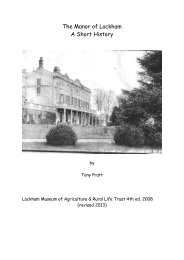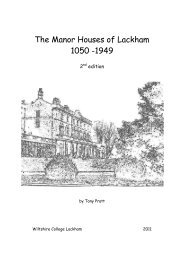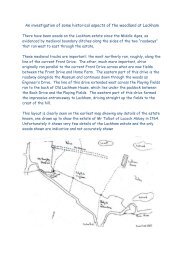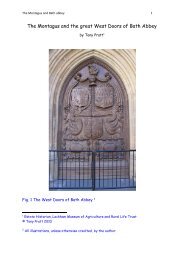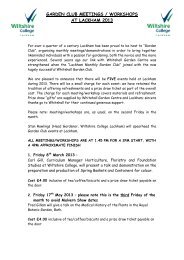History of Agricultural Education in Wiltshire - Lackham Countryside ...
History of Agricultural Education in Wiltshire - Lackham Countryside ...
History of Agricultural Education in Wiltshire - Lackham Countryside ...
Create successful ePaper yourself
Turn your PDF publications into a flip-book with our unique Google optimized e-Paper software.
ema<strong>in</strong>ed to be done, the foundation for a productive relationship between the<br />
Board and <strong>Lackham</strong> College had been laid, to enable both to work together for the<br />
benefit <strong>of</strong> the <strong>Agricultural</strong> Industry.<br />
The first Chairman <strong>of</strong> the new Area Tra<strong>in</strong><strong>in</strong>g Committee was Mr M M Mortimer <strong>of</strong><br />
Broughton Gifford and the first meet<strong>in</strong>g was held <strong>in</strong> Devizes <strong>in</strong> May 1970. At that<br />
meet<strong>in</strong>g, work<strong>in</strong>g parties were set up to produce a programme <strong>of</strong> tra<strong>in</strong><strong>in</strong>g courses <strong>in</strong><br />
the county <strong>in</strong> conjunction with <strong>Lackham</strong> College. At a subsequent meet<strong>in</strong>g <strong>in</strong> July <strong>of</strong><br />
the same year, a programme was approved and later agreed with the L.E.A., for<br />
direct payment by the Board. S<strong>in</strong>ce that time, a steady progress has been made<br />
and whereas <strong>in</strong> 1970 a programme <strong>of</strong> approximately 10 x 1 and 2 day courses were<br />
run, <strong>in</strong> 1976, at the time <strong>of</strong> writ<strong>in</strong>g, this figure is approach<strong>in</strong>g 60 courses, <strong>in</strong>volv<strong>in</strong>g<br />
almost 200 tra<strong>in</strong>ees (from April 1975 to April 1976) <strong>of</strong> all ages. These courses<br />
covered many skills <strong>in</strong>clud<strong>in</strong>g calv<strong>in</strong>g cows us<strong>in</strong>g a plastic simulator, the operation<br />
and ma<strong>in</strong>tenance <strong>of</strong> cha<strong>in</strong> saws and the use <strong>of</strong> the metric system <strong>in</strong> the farm <strong>of</strong>fice.<br />
Similar progress can be recorded <strong>in</strong> the County <strong>in</strong> the recruitment <strong>of</strong> young people<br />
<strong>in</strong>to formal tra<strong>in</strong><strong>in</strong>g schemes. The attached graph shows the numbers <strong>of</strong> formal<br />
apprentices under the old scheme, from 1953 to 1971 and from that year onward<br />
under the new A.T.B. scheme. From the graph aga<strong>in</strong> it may be seen that the years<br />
1970/71 saw the real <strong>in</strong>crease <strong>in</strong> apprentice tra<strong>in</strong>ee numbers <strong>in</strong> the county. A<br />
number <strong>of</strong> developments contributed to this, <strong>in</strong>clud<strong>in</strong>g the formal adoption by the<br />
Industry <strong>of</strong> a wages structure based on Pr<strong>of</strong>iciency Tests and the reconstitution<br />
<strong>of</strong> the A.T.B.<br />
While it was becom<strong>in</strong>g clear that the consistent labour shedd<strong>in</strong>g <strong>of</strong> the previous 20<br />
years <strong>in</strong> agriculture, which had made the old apprenticeship scheme so difficult to<br />
operate <strong>in</strong> a county like <strong>Wiltshire</strong> with its rapid farm mechanisation progress, could<br />
not cont<strong>in</strong>ue <strong>in</strong>def<strong>in</strong>itely at the same rate, it was also apparent to many progressive<br />
farmers that mechanisation had brought its own labour problems. Many tasks now<br />
are carried out on the farm by highly skilled men operat<strong>in</strong>g sophisticated and<br />
complex mach<strong>in</strong>ery <strong>in</strong> isolation and a tra<strong>in</strong>ee, especially a 16 year old, can be at<br />
least an expensive luxury, at most an acceptable liability <strong>in</strong> such situations. Hence<br />
more and more tra<strong>in</strong><strong>in</strong>g has to be done "<strong>of</strong>f the job" <strong>in</strong> a learn<strong>in</strong>g situation.<br />
It was with this problem <strong>in</strong> m<strong>in</strong>d that the first Initial (i.e. basic) Tra<strong>in</strong><strong>in</strong>g Course<br />
was held at <strong>Lackham</strong> <strong>in</strong> 1974, when a small group <strong>of</strong> about 12 school leavers, just<br />
about to enter farm employment, were given a fortnight's <strong>in</strong>tensive <strong>in</strong>struction <strong>in</strong><br />
the basic farm skills <strong>of</strong> tractor driv<strong>in</strong>g and livestock handl<strong>in</strong>g. The course was<br />
jo<strong>in</strong>tly sponsored by the County Council and the A.T.B. and judged to be successful.<br />
A further course was held <strong>in</strong> 1975 and two such courses are planned for 1976. The<br />
time may well come when all young entrants to agriculture will require some sort <strong>of</strong><br />
basic <strong>in</strong>struction along these l<strong>in</strong>es.[i]




